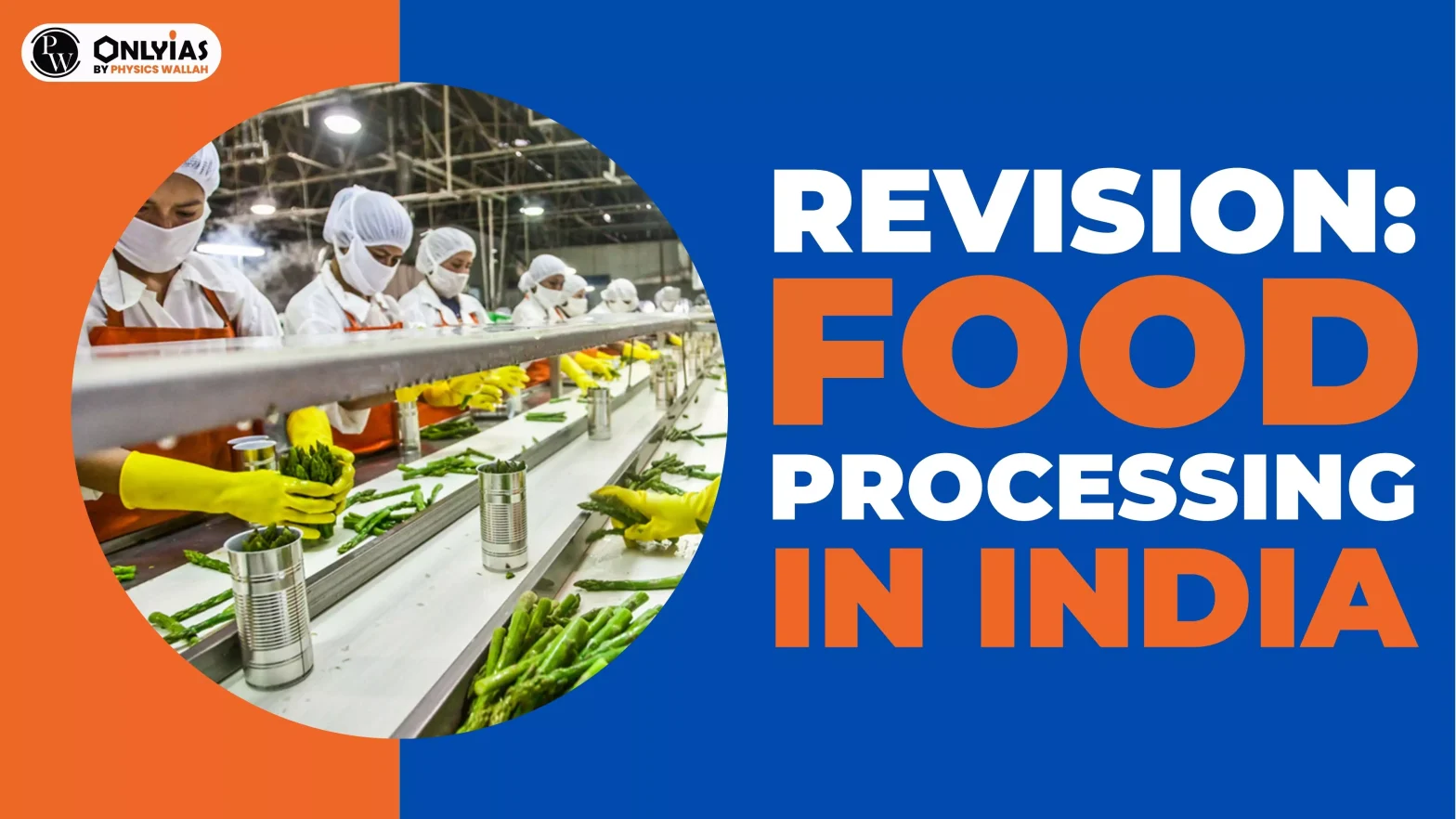Status of Food Processing in India (FPI)
- India’s food production industry is valued at over $400 billion, yet only a small percentage is processed. Despite being the world’s second-largest producer of fruits and vegetables, only about 2% of this produce is processed. Processing levels remain low: 2% of fruits and vegetables, 8% of marine products, 35% of milk, and 6% of poultry.
- Processed food has the potential to significantly increase farmers’ incomes.
- For instance, while selling raw bananas provides limited revenue, processing and selling banana-based products, such as chips or purées, can substantially enhance profitability.
Key Drivers of India’s Food Processing Sector
- Global Leader in Production: India is the second-largest producer of fruits, vegetables, marine products, meat, and poultry, and the world’s largest milk producer with 221.06 million tonnes (2021-22).
- Largest Livestock Population: India has the largest livestock population globally, with 512 million animals, including 119 million milch animals.
- Economic Contribution: Agriculture contributes about 25% to India’s GDP, underscoring its importance in the economy.
Enroll now for UPSC Online Course
Significance of the Food Processing Industry (FPI)
- Sunrise Industry: FPI connects agriculture with industry, playing a crucial role in economic development.
- Employment Generation: FPI offers significant job opportunities, especially in rural areas, and contributes to poverty alleviation, despite 70% being unorganized and contributing only 15% by value.
- Curbing Migration & Food Wastage: FPI reduces rural migration by providing local jobs and cuts food wastage, with only 6% of perishable food currently processed.
- Income & Inflation: FPI boosts farmers’ income through value addition and helps control food inflation by extending food shelf life.
- Nutritional & Environmental Benefits: Processing enhances food nutrition through fortification and encourages crop diversification, improving soil fertility and sustainability.
Scope of Food Processing in India
- Agricultural Strength: India ranks second globally in producing key commodities like rice, wheat, sugarcane, and tea, indicating its strong capacity to contribute to global food supplies.
- Opportunities in Allied Sectors: Significant growth potential exists in processing fruits and vegetables, fisheries, dairy, meat, poultry, and beverages.
- Global Competitiveness: India consistently ranks among the top five in producing coffee, tobacco, spices, and seeds, positioning itself to cater to diverse international markets and demands.
- Urbanization & Market Growth: With urbanisation at 31.16% of the population, rising disposable incomes, changing lifestyles, and a growing demand for processed foods drive market expansion.
Methods for improving this sector
- Village-Level Procurement: NITI Aayog recommends establishing village-level centres for perishables to enhance supply chain efficiency.
- Human Resource Development: As per the National Skill Development Corporation (NSDC), 17.8 million individuals need to be skilled in food processing by 2022. Currently, there are many unskilled workers in the sector.
- Encouraging R&D: R&D drives innovation, improves product quality, and enhances food safety and efficiency in the industry.
- Streamlining Regulations: Developing supportive regulations for contract farming and commodity clusters is essential for economic viability.
- Public-Private Partnerships (PPP): PPPs can foster growth in food processing by investing in infrastructure, technology, and resources through government-private sector collaboration.
Check Out UPSC NCERT Textbooks From PW Store
Constraints and Issues in Food Processing
- Supply and Demand Imbalance: Fragmented holdings, low farm productivity, and high seasonality lead to small, dispersed marketable surpluses.
- Low Value Addition: The industry is highly fragmented, with a significant unorganised segment, resulting in minimal value addition, especially nutritionally.
- Quality and Safety Challenges: The large number of players, particularly in the unorganised sector, makes implementing quality and safety norms difficult.
- Regulatory Complexity: Multiple laws governed by different ministries cause delays in legislative and administrative processes.
- Infrastructure Limitations: Inefficient supply chain mechanics and uneven cold storage distribution lead to regional disparities.
Government Initiatives to Promote the Food Processing Sector
- Pradhan Mantri Kisan SAMPADA Yojana (PMKSY):
- Objective: Modernise food processing and reduce agricultural waste.
- Key Schemes: Mega Food Parks, Integrated Cold Chain, Food Safety and Quality Assurance Infrastructure, and Operation Greens.
- Matsya Sampada Yojana:
- Focus: Sustainable development of the fisheries sector.
- Production Linked Incentive Scheme for Food Processing Industry (PLISFPI):
- Aim: Create global food manufacturing champions and support Indian food brands internationally with a budget of ₹10,900 crore.
- Operation Greens:
- Goal: Develop infrastructure for key perishable products like Tomato, Onion, and Potato (TOP) and expand to 22 products to enhance agricultural exports.
- FSSAI Regulations:
- Focus: Ensure food safety and standards through the Food Safety and Standards (Food Product Standards and Food Additives) Regulations, 2011.
Enroll now for UPSC Online Classes
![]() 12 Sep 2024
12 Sep 2024

